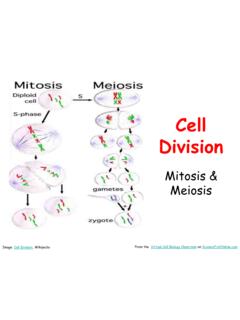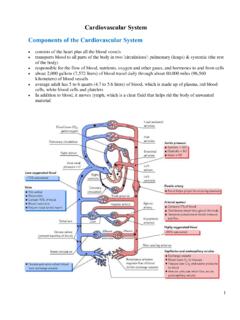Transcription of Cell Walls: Structure, Biogenesis, and Expansion
1 ChapterCell Walls: Structure, Biogenesis, and ExpansionPLANT cells , UNLIKE ANIMAL cells , are surrounded by a rela-tively thin but mechanically strong cell wall. This wall consists of a com-plex mixture of polysaccharides and other polymers that are secreted bythe cell and are assembled into an organized network linked together byboth covalent and noncovalent bonds. Plant cell walls also contain struc-tural proteins, enzymes, phenolic polymers, and other materials thatmodify the wall's physical and chemical cell walls of prokaryotes, fungi, algae, and plants are distinctivefrom each other in chemical composition and microscopic structure, yetthey all serve two common primary functions: regulating cell volumeand determining cell shape.
2 As we will see, however, plant cell wallshave acquired additional functions that are not apparent in the walls ofother organisms. Because of these diverse functions, the structure andcomposition of plant cell walls are complex and addition to these biological functions, the plant cell wall is impor-tant in human economics. As a natural product, the plant cell wall isused commercially in the form of paper, textiles, fibers (cotton, flax,hemp, and others), charcoal, lumber, and other wood products. Anothermajor use of plant cell walls is in the form of extracted polysaccharidesthat have been modified to make plastics, films, coatings, adhesives, gels,and thickeners in a huge variety of the most abundant reservoir of organic carbon in nature, the plantcell wall also takes part in the processes of carbon flow through ecosys-tems.
3 The organic substances that make up humus in the soil and thatenhance soil structure and fertility are derived from cell walls. Finally,as an important source of roughage in our diet, the plant cell wall is asignificant factor in human health and begin this chapter with a description of the general structure andcomposition of cell walls and the mechanisms of the biosynthesis andsecretion of cell wall materials. We then turn to the role of the primarycell wall in cell Expansion . The mechanisms of tip growth will be con-trasted with those of diffuse growth, particularly with respect to the314 Chapter 15establishment of cell polarity and the control of the rate ofcell Expansion .
4 Finally, we will describe the dynamicchanges in the cell wall that often accompany cell differ-entiation, along with the role of cell wall fragments as sig-naling STRUCTURE AND SYNTHESIS OFPLANT CELL WALLSW ithout a cell wall, plants would be very different organ-isms from what we know. Indeed, the plant cell wall isessential for many processes in plant growth, development,maintenance, and reproduction: Plant cell walls determine the mechanical strength ofplant structures, allowing those structures to grow togreat heights. Cell walls glue cells together, preventing them fromsliding past one another.
5 This constraint on cellularmovement contrasts markedly to the situation in ani-mal cells , and it dictates the way in which plantsdevelop (see Chapter 16). A tough outer coating enclosing the cell, the cell wallacts as a cellular "exoskeleton" that controls cellshape and allows high turgor pressures to develop. Plant morphogenesis dependslargely on the control of cell wallproperties because the expansivegrowth of plant cells is limited prin-cipally by the ability of the cell wallto expand. The cell wall is required for normalwater relations of plants because thewall determines the relationshipbetween the cell turgor pressure andcell volume (see Chapter 3).
6 The bulk flow of water in the xylemrequires a mechanically tough wallthat resists collapse by the negativepressure in the xylem. The wall acts as a diffusion barrierthat limits the size of macromole-cules that can reach the plasmamembrane from outside, and it is amajor structural barrier to of the carbon that is assimilatedin photosynthesis is channeled into poly-saccharides in the wall. During specificphases of development, these polymersmay be hydrolyzed into their constituentsugars, which may be scavenged by thecell and used to make new polymers. Thisphenomenon is most notable in many seeds, in which wallpolysaccharides of the endosperm or cotyledons functionprimarily as food reserves.
7 Furthermore, oligosaccharidecomponents of the cell wall may act as important signalingmolecules during cell differentiation and during recogni-tion of pathogens and diversity of functions of the plant cell wall requiresa diverse and complex plant cell wall structure. In this sec-tion we will begin with a brief description of the morphol-ogy and basic architecture of plant cell walls. Then we willdiscuss the organization, composition, and synthesis of pri-mary and secondary cell Cell Walls Have Varied ArchitectureStained sections of plant tissues reveal that the cell wall isnot uniform, but varies greatly in appearance and compo-sition in different cell types (Figure ).
8 Cell walls of thecortical parenchyma are generally thin and have few dis-tinguishing features. In contrast, the walls of some spe-cialized cells , such as epidermal cells , collenchyma, phloemfibers, xylem tracheary elements, and other forms of scle-renchyma have thicker, multilayered walls. Often thesewalls are intricately sculpted and are impregnated withspecific substances, such as lignin, cutin, suberin, waxes,silica, or structural Cross section of a stem of Trifolium (clover), showing cellswith varying wall morphology. Note the highly thickened walls of thephloem fibers. (Photo James Solliday/Biological Photo Service.)
9 Cell Walls: Structure, Biogenesis, and Expansion315 The individual sides of a wall surrounding a cell may alsovary in thickness, embedded substances, sculpting, and fre-quency of pitting and plasmodesmata. For example, the outerwall of the epidermis is usually much thicker than the otherwalls of the cell; moreover, this wall lacks plasmodesmataand is impregnated with cutin and waxes. In guard cells , theside of the wall adjacent to the stomatal pore is much thickerthan the walls on the other sides of the cell. Such variationsin wall architecture for a single cell reflect the polarity anddifferentiated functions of the cell and arise from targetedsecretion of wall components to the cell this diversity in cell wall morphology, cell wallscommonly are classified into two major types: primarywalls and secondary walls.
10 Primary walls are formed bygrowing cells and are usually considered to be relativelyunspecialized and similar in molecular architecture in allcell types. Nevertheless, the ultrastructure of primarywalls also shows wide variation. Some primary walls,such as those of the onion bulb parenchyma, are very thin(100 nm) and architecturally simple (Figure ). Otherprimary walls, such as those found in collenchyma or inthe epidermis (Figure ), may be much thicker and con-sist of multiple walls are the cell walls that form after cellgrowth (enlargement) has ceased. Secondary walls maybecome highly specialized in structure and composition,reflecting the differentiated state of the cell.









